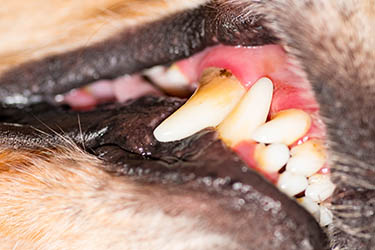What is canine periodontal disease?

Contrary to a common misconception, canine periodontal disease is a condition that affects a dog’s gums, rather than originating in the teeth themselves. Tooth loss and decay usually occur as a direct result of advanced periodontal disease.
Canine periodontal disease develops when plaque and tartar extend beneath the gumline. The bacteria that are present in this “subgingival” plaque then begin to secrete toxins that result in inflammation, causing damage to the supporting tissues around the teeth.
According to Dr. James Anthony, DVM, BSc (Agr.), MRCVS, FAVD, DAVDC, DEVDC, PAg, oral health issues are the #1 problem facing pets.
And by the time they reach three years of age, roughly 80% of dogs have oral health issues, with many showing the tell-tale signs of early onset periodontal disease.
But, other than foul breath odor, which many owners just write off as “dog breath,” there are a few other symptoms of the disease process during its early stages. Consequently, periodontal disease often goes untreated, leading to multiple problems for your pet, including pain and, eventually, tooth loss.
In addition, some studies have shown that older animals with advanced periodontal disease often display evidence of liver, kidney, and heart damage.
What causes canine periodontal disease?
A dog’s mouth is full of bacteria. Almost immediately after a dog eats, food, saliva, and bacteria begin to form a sticky film over the exposed surfaces of the animal’s teeth. Over time, minerals in the dog’s saliva react with the plaque, causing it to harden into tartar (dental calculus), which remains firmly attached to the teeth.
Although tartar is unsightly, it is not the actual cause of periodontal disease, but together with gum inflammation, is a diagnostic indication of it.
The bacteria contained in plaque are deemed foreign invaders by the dog’s immune system, triggering white blood cells (leucocytes) and inflammatory chemical signals. The leucocytes and other chemical messengers travel to the space between the bone or gum and the tooth. The white blood cells’ function is to destroy the invading bacteria. However, chemicals produced by the white cells actually inflict damage on the gums and the tooth’s supporting tissues. Rather than helping to tackle the problem, the dog’s own natural defenses only serve to make the whole situation worse.
Canine periodontal disease has four recognizable stages

Grade 1 – Gingivitis
The first sign of impending periodontal disease is when the dog develops “gingivitis.”
Gingivitis is a medical term, meaning inflammation of the gums. The condition occurs when bacteria enter the gingival sulcus, the small pocket between the tooth and the gum.
The dog’s gums will appear swollen and red around the tooth margins and may bleed when the teeth are brushed. A film of plaque will coat the teeth. Gingivitis is almost always accompanied by foul “dog breath.”
Grade 2 – Early periodontitis
In the early stages of periodontal disease, the inflammation of the gums becomes more pronounced. Subgingival plaque and tartar have formed and bone loss has commenced, although the tooth root is not exposed at this stage.
Grade 3 – Established periodontitis
As the disease becomes more established, the dog’s gums appear generally inflamed and reddened. The gums bleed easily when the dog is eating or playing with toys, or when the dog’s teeth are brushed.
Below the gumline, up to 30 percent of the tooth’s supporting structures have been permanently damaged by infection and tartar. At this stage, teeth in affected areas of the mouth may become loose.
Grade 4 – Advanced periodontitis
In advanced periodontitis, chronic inflammation has set in, destroying the teeth, gums, and supporting bone. The gums usually recede, exposing the roots of the affected teeth and causing the dog severe pain.
In severe cases, a fistula (hole) may form from the oral cavity into the dog’s nasal passages, causing continual, chronic nasal discharge. Severe infection of the jawbone (osteomyelitis) can weaken the whole structure, leading to fractures.
Inflammatory by-products readily spread through the dog’s body carried by the bloodstream, potentially causing damage to the vital organ systems.
Signs and symptoms of canine periodontal disease
Dogs are instinctually reluctant to show signs of weakness, and this is one of the reasons that canine periodontal disease often goes undetected until it has become established.
Dr. Anthony notes that there are many classic signs and symptoms of early periodontal disease dog owners should be aware of:
- foul breath
- red, swollen gums
- loose teeth
- plaque and tartar on the dog’s teeth
As periodontal disease progresses, the following signs may appear:
- reluctance to eat; difficulty eating and chewing
- bleeding gums
In advanced cases of periodontal disease, the dog will exhibit the following signs:
- teeth “chattering” (in response to discomfort or pain)
- depression
- receding gums
- loose or lost teeth
- weight loss
- other associated conditions such as kidney or liver problems
- weakness, lethargy
Canine periodontal disease is preventable
- Canine periodontal disease can be prevented if it is recognized and treated early.
- Bacteria in the dog’s mouth are responsible for forming plaque on the teeth, which forms tartar when combined with saliva.
- When tartar extends below the gumline, periodontal disease begins.
- If left untreated, periodontal disease can result in pain and tooth loss.
- Advanced Grade 4 periodontal disease can result in serious health complications, including kidney and liver disease.
- If your dog shows any of the classic signs of canine periodontal disease outlined above, seek veterinary advice right away!
About Dr. James Anthony
Dr. James Anthony has been involved in veterinary medicine for
over 30 years. He is a boarded Veterinary Dentist since 1989 (Diplomate of the AVDC).
Dr. Anthony has had an extensive academic career as well, having
taught veterinary dentistry at the University of Guelph, the University of Montreal and the University of Prince Edward Island. He was also a Tenured Professor at the University of Saskatchewan as the Head of
Veterinary Oral Surgery and Dentistry.
Dr. Anthony has authored over 40 articles and book chapters, and throughout his career has lectured globally at veterinary meetings.


Working Here
Our team members are encouraged to be the best they can be... at Covetrus we believe we impact one another.
Learn MoreNews & Events
FDA Cautions Pet Owners Not to Feed Texas Tripe Inc. Raw Pet Food Due to Salmonella, Listeria Monocytogenes
The U.S. Food and Drug Administration is cautioning pet owners not to feed their pets any of the Texas Tripe brand raw frozen pet food listed below because several samples of Texas Tripe raw pet food have tested positive for Salmonella and/or L. mono.
Careers
Are you looking for a place to let your talents shine? At Covetrus, we help our practitioner customers better serve their patients and take pride in providing the best customer experience possible. Search our open positions to see our available opportunities.
Newsletter
Stay current with what’s going on with Covetrus, subscribe to receive our newsletter and email communications. Subscribers will receive the latest information in practice management, sales and marketing, animal health, and more.



-3-(1).png?sfvrsn=2d806d73_0)

Leave a comment